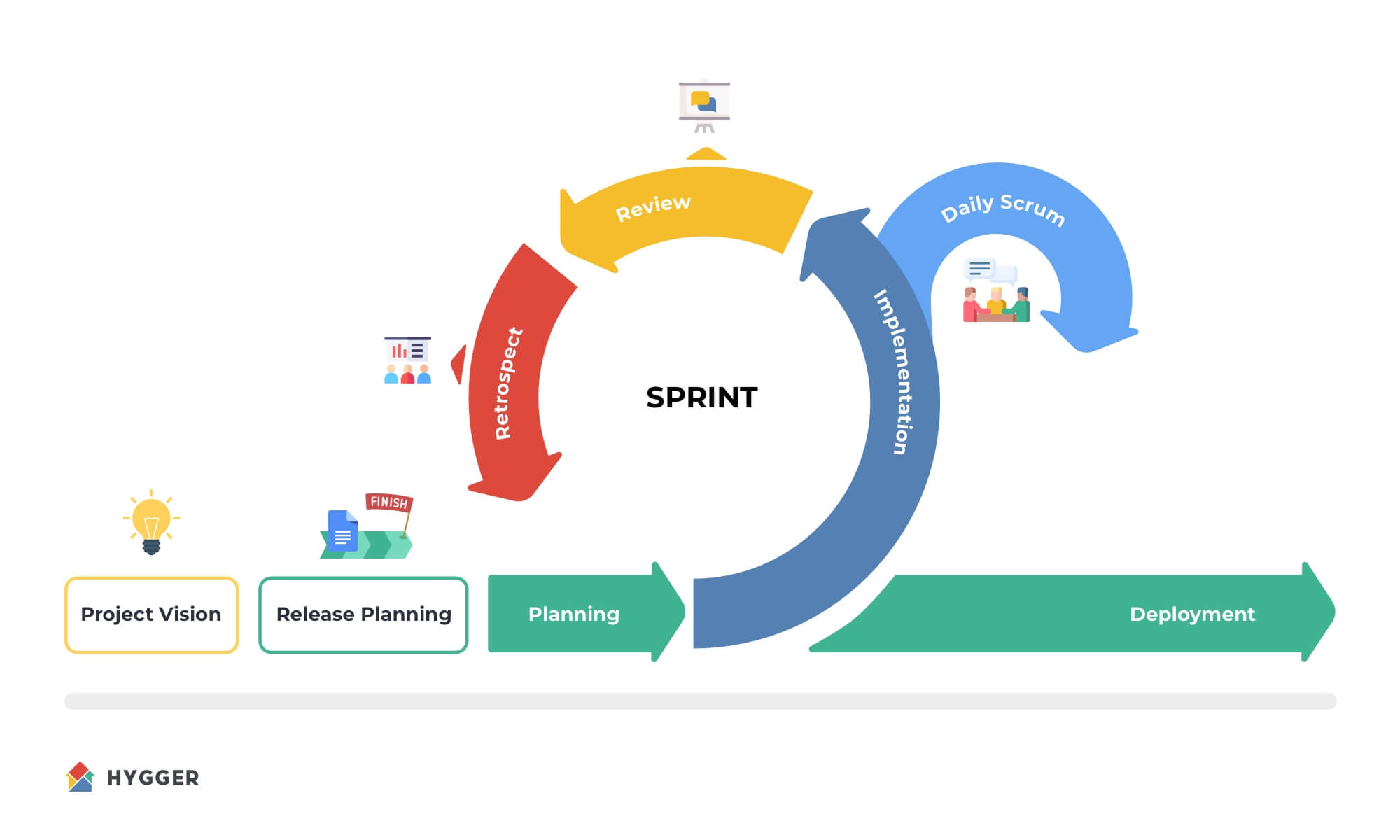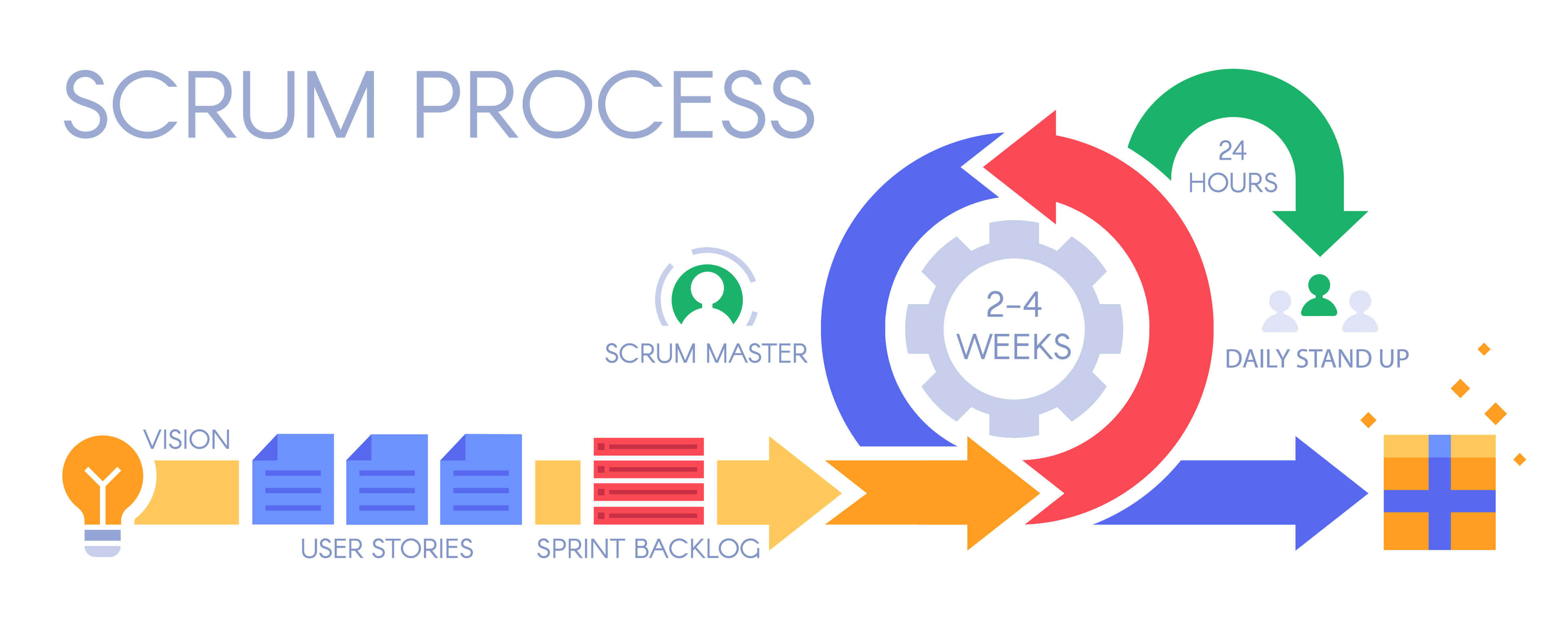The Scrum Framework: A Brief Overview
Scrum is an Agile software development framework that emphasizes collaboration, accountability, and efficiency. Its primary components include Sprints, Product Backlog, Sprint Backlog, and Scrum Roles. Sprints are timeboxed iterations, typically lasting 1-4 weeks, during which a cross-functional Development Team completes a set list of prioritized work items from the Product Backlog. The focus of this article is to understand the time interval between Sprints, a critical aspect of the Scrum framework that can significantly impact the Scrum Team’s performance.
Understanding the Sprint Concept
In Scrum, a Sprint is a timeboxed iteration ranging from 1-4 weeks, during which a Development Team completes a set list of prioritized work items from the Product Backlog. The Sprint’s primary purpose is to create a potentially shippable product increment, allowing the Scrum Team to inspect and adapt its progress regularly. Timeboxing Sprints ensures a consistent rhythm for the team, fostering a sense of urgency and focus. The time interval between Sprints is a critical aspect of the Scrum framework, as it influences the team’s performance, productivity, and ability to deliver high-value product increments.
The Role of Sprint Planning and Sprint Review Meetings
Sprint Planning and Sprint Review meetings are essential events in the Scrum framework that influence the time interval between Sprints. Sprint Planning marks the beginning of a new Sprint, where the Product Owner and Development Team collaborate to select items from the Product Backlog and define the Sprint Goal. This meeting sets the stage for the upcoming Sprint, allowing the team to align on expectations and work distribution. A well-executed Sprint Planning meeting ensures that the Development Team has a clear understanding of the work to be done during the Sprint, minimizing the risk of misunderstandings or miscommunications.
At the end of each Sprint, the Scrum Team conducts a Sprint Review meeting to inspect the increment and adapt the Product Backlog if necessary. This meeting provides an opportunity for stakeholders to review the team’s progress, offer feedback, and help shape future work items. By evaluating the product increment and soliciting input from stakeholders, the Scrum Team can ensure that it stays aligned with organizational goals and customer needs. The Sprint Review meeting also serves as a platform for the team to reflect on its performance and identify areas for improvement, fostering a culture of continuous learning and development.
The time interval between Sprints plays a crucial role in the effectiveness of these meetings. A well-balanced interval allows the team to maintain focus and momentum while ensuring that there is sufficient time for planning, execution, and reflection. By carefully managing the time interval between Sprints, Scrum Teams can optimize their performance and deliver high-value product increments consistently.
Recommended Time Interval Between Sprints
The recommended time interval between Sprints in a Scrum Team typically ranges from 1 to 4 weeks. This duration allows teams to strike a balance between focus and flexibility, ensuring that they can deliver high-value product increments consistently while remaining adaptable to changing requirements. A shorter interval, such as one week, can help increase focus and foster faster feedback loops, enabling the team to identify and address issues promptly. However, shorter intervals may also introduce additional pressure and require more frequent planning and coordination efforts.
On the other hand, longer intervals, such as four weeks, can provide teams with more extensive planning opportunities and reduce the pressure associated with frequent deliveries. This approach may be particularly beneficial for teams working on complex projects or those with significant dependencies between tasks. However, longer intervals can also lead to slower feedback loops and increased risk, as issues may remain undetected for extended periods.
The optimal time interval between Sprints depends on several factors, including the team’s maturity, project complexity, and organizational goals. For instance, a more experienced team working on a straightforward project may benefit from shorter intervals, while a less experienced team working on a complex project might find longer intervals more suitable. It is essential to consider these factors when determining the ideal time interval for a Scrum Team, as a well-balanced interval can significantly impact the team’s performance and productivity.
Factors Influencing the Time Interval Between Sprints
Several factors can influence the time interval between Sprints in a Scrum Team, including team size, project complexity, and organizational constraints. Here, we discuss these factors and provide examples and best practices for adjusting the time interval based on these factors.
Team Size
Larger teams may require longer intervals between Sprints to accommodate the increased complexity and coordination efforts associated with a larger group. Smaller teams, on the other hand, might benefit from shorter intervals, as they can more easily maintain focus and adapt to changing requirements.
Project Complexity
Complex projects often necessitate longer intervals between Sprints, providing teams with more extensive planning opportunities and reducing the risk of overlooking critical dependencies or issues. Simpler projects, however, might benefit from shorter intervals, enabling teams to maintain a fast pace and quickly respond to changing requirements.
Organizational Constraints
Organizational constraints, such as release cycles, regulatory requirements, or resource availability, can also impact the time interval between Sprints. Teams must consider these constraints when determining their Sprint duration, ensuring that they can deliver high-value product increments while adhering to organizational policies and procedures.
In general, teams should aim to strike a balance between focus and flexibility when determining the time interval between Sprints. By carefully considering the factors that influence this interval, teams can optimize their performance and deliver high-value product increments consistently.
Balancing Time Intervals for Effective Scrum Teams
Balancing the time interval between Sprints is crucial for optimal team performance in a Scrum environment. While shorter intervals offer increased focus and faster feedback loops, longer intervals provide reduced pressure and more extensive planning opportunities. Here, we discuss the benefits of both shorter and longer intervals and offer guidance on finding the right balance for your team.
Benefits of Shorter Intervals
Shorter intervals between Sprints can lead to increased focus and faster feedback loops, enabling teams to quickly identify and address issues. This approach can be particularly beneficial for teams working on straightforward projects or those seeking to maintain a fast pace. Additionally, shorter intervals can foster a sense of urgency and encourage teams to stay on track and meet their commitments.
Benefits of Longer Intervals
Longer intervals between Sprints can provide teams with more extensive planning opportunities and reduce the pressure associated with frequent deliveries. This approach may be particularly suitable for teams working on complex projects or those with significant dependencies between tasks. Furthermore, longer intervals can allow teams to accommodate organizational constraints, such as release cycles or regulatory requirements.
To strike the right balance, Scrum Teams should consider factors such as team size, project complexity, and organizational constraints. By carefully weighing these factors, teams can determine the optimal time interval between Sprints, ensuring that they can deliver high-value product increments consistently while maintaining focus and flexibility.
Continuous Improvement: Adjusting Time Intervals Over Time
Continuous improvement is a key principle in Scrum, and teams should regularly evaluate their performance and make data-driven decisions about adjusting the time interval between Sprints. As the team matures and project requirements change, it is essential to revisit the time interval and ensure that it remains optimal for the team’s performance.
Monitoring team performance can be achieved through various metrics, such as velocity, cycle time, and lead time. By tracking these metrics over several Sprints, teams can identify trends and patterns that may indicate the need for a time interval adjustment. For instance, if a team consistently delivers high-value product increments ahead of schedule, they may consider shortening the time interval between Sprints to maintain their momentum and increase focus.
On the other hand, if a team struggles to meet their commitments or frequently encounters unforeseen issues, they may benefit from lengthening the time interval between Sprints to allow for more extensive planning and coordination efforts. In either case, it is crucial to base decisions on data and empirical evidence, rather than assumptions or anecdotal observations.
To facilitate continuous improvement in Scrum Teams, Scrum Masters, Product Owners, and Development Teams should maintain open communication channels, foster a culture of collaboration, and be willing to experiment with different time intervals to find the optimal balance for their unique context.
Practical Considerations for Managing Time Intervals Between Sprints
Managing the time interval between Sprints requires careful consideration and strategic planning. Here, we offer practical advice for Scrum Masters, Product Owners, and Development Teams on handling unexpected changes, maintaining transparency, and fostering a culture of collaboration and communication.
Handling Unexpected Changes
In Scrum, change is inevitable, and teams must be prepared to adapt to new requirements or shifting priorities. When handling unexpected changes, it is essential to consider the impact on the current Sprint and any potential adjustments to the time interval between Sprints. If a significant change arises mid-Sprint, the team may need to reassess their progress, adjust their goals, and potentially extend the current Sprint or shorten the time interval between Sprints to accommodate the new work.
Maintaining Transparency
Transparency is a cornerstone of the Scrum framework, and maintaining open communication channels between the Development Team, Product Owner, and Scrum Master is crucial for managing the time interval between Sprints effectively. Regularly scheduled meetings, such as Daily Scrums and Sprint Reviews, provide opportunities for the team to discuss their progress, identify potential issues, and make informed decisions about the time interval between Sprints.
Fostering a Culture of Collaboration and Communication
Creating an environment that encourages collaboration and communication can help Scrum Teams manage the time interval between Sprints more effectively. By fostering a culture where team members feel comfortable sharing their thoughts, concerns, and ideas, teams can more easily adapt to changing circumstances and make data-driven decisions about the time interval between Sprints.
In conclusion, managing the time interval between Sprints requires careful consideration, strategic planning, and ongoing evaluation. By handling unexpected changes, maintaining transparency, and fostering a culture of collaboration and communication, Scrum Teams can optimize their performance and deliver high-value product increments consistently.






